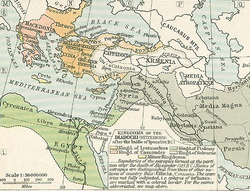Atropatene: Difference between revisions
GrouchoBot (talk | contribs) m robot Adding: sh:Atropatena |
cleanup |
||
| Line 55: | Line 55: | ||
may have been the southern border.". pg 1293: "Another important site (but not as large as the places just noted) is the famous fire-temple Adur |
may have been the southern border.". pg 1293: "Another important site (but not as large as the places just noted) is the famous fire-temple Adur |
||
Gushnasp, situated high in the Kurdish mountains at the holy lake of Takht-i Suleiman, and never mentioned by any |
Gushnasp, situated high in the Kurdish mountains at the holy lake of Takht-i Suleiman, and never mentioned by any |
||
ancient western source. It"[http://books.google.com/books?id=x_FHmc_E2uQC&pg=PA1293&dq=Another+important+site+(but+not+as+large+as+the+places+just+noted)+is+the+famous+fire-temple+Adur&cd=1#v=onepage&q=Another%20important%20site%20(but%20not%20as%20large%20as%20the%20places%20just%20noted)%20is%20the%20famous%20fire-temple%20Adur&f=false] </ref>. Its capital was [[Gazaca]]. ''Atropatene'' also was the nominal ancestor of the name ''[[Azerbaijan (disambiguation)|Azarbaijan]]''. Its capital was [[Gazaca]]. |
ancient western source. It"[http://books.google.com/books?id=x_FHmc_E2uQC&pg=PA1293&dq=Another+important+site+(but+not+as+large+as+the+places+just+noted)+is+the+famous+fire-temple+Adur&cd=1#v=onepage&q=Another%20important%20site%20(but%20not%20as%20large%20as%20the%20places%20just%20noted)%20is%20the%20famous%20fire-temple%20Adur&f=false] </ref>. Its capital was [[Gazaca]]. ''Atropatene'' also was the nominal ancestor of the name ''[[Azerbaijan (disambiguation)|Azarbaijan]]''. Its capital was [[Gazaca]]. |
||
==History== |
==History== |
||
Revision as of 19:27, 4 February 2010
Atropatene | |||||||||
|---|---|---|---|---|---|---|---|---|---|
| 320s BC–200s AD | |||||||||
 Western Asia and the Eastern Mediterranean following the Fourth War of the Diadochi in 301 BCE.
| |||||||||
| Capital | Ganzak | ||||||||
| Government | Monarchy | ||||||||
| King | |||||||||
| Historical era | Antiquity | ||||||||
• Established | 320s BC | ||||||||
• Disestablished | 200s AD | ||||||||
| |||||||||
Atropatene or Media Atropatene was an ancient kindom established and ruled by Iranian[1] dynasts in the 4th century BC in modern Iranian Azarbaijan[2] and Iranian Kurdistan[3]. Its capital was Gazaca. Atropatene also was the nominal ancestor of the name Azarbaijan. Its capital was Gazaca.
History
Following the death of Alexander the Great in 323 BCE, the Macedonian's conquests were divided amongst the diadochi at the Partition of Babylon. The former Achaemenid satrapy of Media was divided into two states: The greater (southern) part - Media Magna was assigned to Peithon, one of Alexander's bodyguards. The smaller (northern) region, which had been the sub-satrapy of Matiene, became Media Atropatene under Atropates, the former Achaemenid governor of all Media, who had by then become father-in-law of Perdiccas, regent of Alexander's designated successor.
Shortly thereafter, Atropates refused to pay allegiance to Seleucus, and made Media Atropatene an independent kingdom. It subsequently lost the Media prefix in the name and came to be known simply as Atropatene The dynasty Atropates founded would rule the kingdom for several centuries, first independently, then as vassals of the Arsacids (who called it 'Aturpatakan'). It was eventually annexed by the Arsacids, who then lost it to the Sassanids, who again called it 'Aturpatakan'. The Arabs under the Rashidun took control of the area during the reign of Umar, at some time between 639 and 643. Atropatene formed a separate province of the early Islamic caliphate and was considered to have had strategic importance. It was during the Arab period that Middle Iranian (i.e. Parthian and Middle Persian) Aturpatakan became Adarbaygan, Adarbayjan, Azarbaijan,.
List of rulers
- Artabazanes, ruled 221 BCE or 220 BCE, a contemporary of Antiochus III the Great.
- Mithridates I, (b. 100 BCE - d. ca. 66 BCE), ruled from 67 BCE to ca. 66 BCE, a son-in-law of Tigranes the Great.
- Aristobanes I, (b. 85 BCE-d. 56 BCE), ruled from 65 BCE to 56 BCE.
- Darius, (b. ca.85 BCE-d. ca.65 BCE), ruled ca. 65 BCE.
- Artavasdes I, (b. 65 BCE-d. 20 BCE), ruled from 56 BCE to 31 BCE, a son-in-law of Antiochus I Theos of Commagene.
- Aristobanes II, (b. 40 BCE-d. AD 2), ruled from 28 BCE to 8 BCE, also as Aristobanes, king of Armenia from 2 BCE to AD 2.
- Artavasdes III, (b. 20 BCE-d. AD 4), as Artavasdes IV, king of Armenia from AD 2 to AD 4.
References
- ^ Susan M. Sherwin-White, Amélie Kuhrt, "From Samarkhand to Sardis: a new approach to the Seleucid Empire", University of California Press, 1993. pg 78:" The independence of the area Media Atropatene, named after Atropates, satrap of Media under Darius and Alexander (now Azerbaijan), under local Iranian dynasts, was pre-Selecuid"
- ^ Benson, Douglas S. (1995). Ancient Egypt's warfare: a survey of armed conflict in the chronology of ancient Egypt, 1600 BC-30 BC. D. S. Benson.
{{cite book}}: Cite has empty unknown parameter:|coauthors=(help) - ^ Media Atropatene, Compiled by S.E. Kroll, 1994 in Barrington Atlas of the Greek and Roman World: Map-by-map Directory, Richard J. A. Talbert, Princeton University Press, 2000. Volume 2. pg 1292: "The map approximates the region called by Greek authors Media Atropatene after Atropates, the satrap of Alexander who governed there and later became an independent ruler. The modern name Azerbaijan derives from Atropatene. Originally, Media Atropatene was the northern part of greater Media. To the north, it was separated from Armenia by the R. Araxes. To the east, it extended as far as the mountains along the Caspian Sea, and to the west as far as Lake Urmia (ancient Matiane Limne) and the mountains of present-day Kurdistan. The R. Amardos may have been the southern border.". pg 1293: "Another important site (but not as large as the places just noted) is the famous fire-temple Adur Gushnasp, situated high in the Kurdish mountains at the holy lake of Takht-i Suleiman, and never mentioned by any ancient western source. It"[1]
- Играр Алиев. Очерк Истории Атропатены (Азернешр, 1989) ISBN 5-552-00480-9
- Chaumont, M. L. (1989), "Atropates", Encyclopaedia Iranica, vol. 3.1, London: Routledge & Kegan Paul
- de Planhol, X. (1989), "Azerbaijan I: Geography", Encyclopaedia Iranica, vol. 3.1, London: Routledge & Kegan Paul
- Schippmann, K. (1989), "Azerbaijan III: Pre-Islamic History", Encyclopaedia Iranica, vol. 3.1, London: Routledge & Kegan Paul
- Bosworth, C.E. (1989), "Azerbaijan IV: Islamic History to 1941", Encyclopaedia Iranica, vol. 3.1, London: Routledge & Kegan Paul
